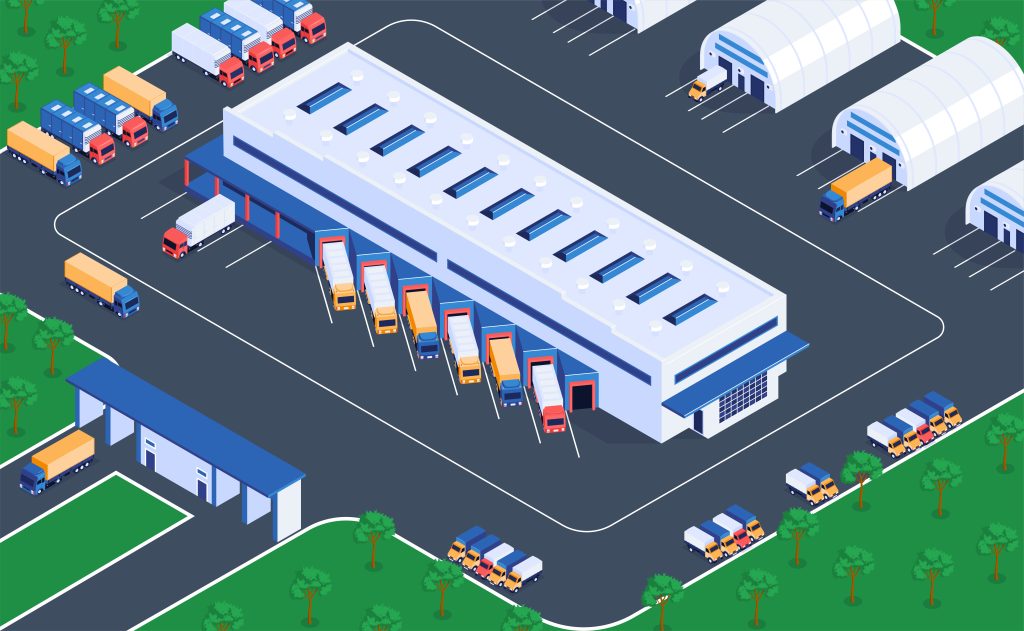Temporary vs. Long-Term Industrial Yard Storage: Which Is Right for You?

From construction contractors staging equipment for a 16-week project to manufacturers parking overflow inventory for the year, every operation eventually faces the same question: Do we need temporary yard space or a long-term industrial storage yard? The right answer depends on project length, access needs, risk profile, and budget. This guide breaks down the trade-offs so you can choose with confidence.
What Is Industrial Yard Storage?
An industrial storage yard is an outdoor, often secured space designed to store heavy equipment, materials, shipping containers, fleet vehicles, and other bulky assets that don’t need to live inside a warehouse. Unlike warehouses, yards prioritize access, maneuverability, and durability over climate control. Think graded surfaces, wide turning radii, reinforced gates, lighting, and sometimes utilities (power/water) or office trailers for on-site coordination.
Who uses it? Construction, logistics, energy, manufacturing, marine/ports, and utility contractors.
What’s stored? Steel, lumber, piping, forms, aggregates, containers, heavy machinery, trailers, and seasonal inventory.
Temporary Industrial Yard Storage
Timeframe: Weeks to a few months.
When It Fits Best
- Short, project-based work (e.g., a bridge repair, retail buildout, or utility upgrade).
- Seasonal spikes in inventory or fleet, such as peak holiday logistics.
- Trial runs in a new market before committing to a permanent footprint.
- Emergency or disaster response staging.
Advantages
- Speed & Flexibility: Stand up space quickly, scale up/down as project scope shifts.
- Lower Short-term Commitment: Avoid long leases while you validate demand.
- Proximity to Project Sites: Reduce deadhead miles and turnaround times.
Potential Drawbacks
- Cost Creep If Extended: Month-to-month can get expensive if your “short-term” need lasts a year.
- Limited Infrastructure: Some temporary yards offer basic fencing and lighting only.
- Availability Risk: Prime locations may not be available at the exact time you need them.
Long-Term Industrial Yard Storage
Timeframe: Several months to multiple years.
When It Fits Best
- Ongoing material staging for multi-year programs (utilities, energy, infrastructure).
- Fleet parking/maintenance, container depots, and cross-dock support.
- Manufacturing overflow or returns processing that requires predictable access.
- Strategic market presence and customer SLAs that demand consistency.
Advantages
- Stability & Predictability: Fixed location, predictable pricing, consistent workflows.
- Better Infrastructure: Higher security, paved or stabilized surfaces, lighting, utilities, offices, even racking or laydown organization.
- Operational Efficiency: Repeatable yard maps, dedicated lanes, trained yard staff, and integrated systems (RFID/GPS) reduce handling time and loss.
Potential Drawbacks
- Reduced Flexibility: Lease commitments may outlast project changes.
- Capex or Setup Costs: Upgrades (surfacing, power drops, security) can be front-loaded.
- Utilization Risk: If demand dips, you could be paying for space you don’t use.
Key Factors to Consider
Use these lenses to make a clean decision.
1. Project Duration & Forecastability
- If your need is clearly time-boxed, start temporary.
- If storage is part of BAU (business as usual), long-term wins on stability.
2. Throughput & Access Frequency
- Daily ins/outs, crane picks, or frequent re-slotting benefit from a long-term yard with defined circulation, staging zones, and on-site staffing.
- Infrequent access—like storing spare equipment—may stay economical as temporary.
3. Asset Value & Risk Tolerance
- High-value equipment, regulated materials, or theft-prone inventory typically justify long-term yards with better security (controlled access, CCTV, lighting, patrols).
- Low-value, low-risk items can sit in a basic laydown temporary yard.
4. Location & Travel Time
- The closer the yard to your sites, the more you save on fuel, driver hours, and equipment wear. A short-term yard near each project can beat one long-term yard far away.
5. Scalability
- Expecting to ramp from 1 to 3 acres? Temporary yards help you test footprint.
- Stable programs with seasonal variance might pair a core long-term yard with short-term overflow.
6. Compliance & Permits
- Some materials require specific storage practices, stormwater controls, or permits. Long-term yards are more likely to have compliant infrastructure baked in.
7. Budget Structure
- Temporary: higher monthly rate, minimal commitment.
- Long-term: lower effective monthly cost, possible setup investments.
Quick Comparison
| Consideration | Temporary Yard | Long-Term Yard |
| Commitment | Flexible, month-to-month | Multi-month/years |
| Speed to Launch | Fast | Moderate (setup, upgrades) |
| Cost Over 3–6 Months | Often lower | Can be higher initially |
| Cost Over 12–24 Months | Often higher | Usually lower |
| Security/Infrastructure | Basic to moderate | Moderate to robust |
| Best For | Projects, pilots, overflow | Ongoing programs, fleets |
Cost Comparison: Where the Money Really Goes
Direct Costs: Monthly rent/acre, equipment rentals (forklifts, cranes), utilities, security services, and any surface prep.
Indirect Costs: Transport to/from job sites, driver hours, fuel, admin time, loss/shrink, delays due to poor yard layout.
Example scenarios
- Short Project (4 Months): A temporary yard 10 minutes from site can beat a cheaper long-term yard 45 minutes away, once you factor driver hours and fuel.
- Ongoing Program (24 Months): A long-term yard with better rates and on-site infrastructure usually outperforms temporary space, especially if you visit the yard daily.
Hidden Costs to Watch: Permits, stormwater management, insurance requirements, security upgrades, surface stabilization (e.g., aggregate), and demobilization fees.
Industry Use Cases
Construction: Prefers temporary yards near active projects for staging rebar, forms, and equipment—then demobilizes when the job ends.
Manufacturing: Long-term yards handle steady overflow of raw materials, finished goods, and returns, with routine daily access and tighter security.
Logistics/3PL: Often run a hybrid approach—maintain a core long-term yard for fleet and containers, then spin up temporary yards for peak season.
Energy & Utilities: Multi-year programs (transmission, pipelines, renewables) benefit from long-term yards with environmental controls and secure storage for high-value assets.
Hybrid Solutions: Best of Both Worlds
Many operators blend models to match demand:
- Core + Overflow: Lock in a long-term yard for baseline operations; add temporary acres within peak regions during surges.
- Phased Commitment: Start temporary to validate volume and traffic patterns, then convert to a long-term lease once the business case is proven.
- Specialized Nodes: Use a long-term hub with utilities and security, plus smaller temporary spokes close to dynamic project sites.
A good yard provider can customize surface types, access control, staging maps, and even on-site staff to match your exact flow.
How to Decide in 10 Minutes
1. Map your demand curve (project dates, seasonal spikes).
2. Estimate weekly yard touches (ins/outs, picks).
3. Assign a risk level to your assets (low/medium/high).
4. Calculate travel time from candidate yards to your sites.
5. Compare 6-month and 24-month TCO (rent + transport + labor + shrink).
6. Choose the model that minimizes TCO and meets your risk tolerance.
Bottom Line
If your storage need is short, unpredictable, or tied to a specific project, temporary industrial yard storage keeps you nimble and close to the action. If your operation is steady, high-touch, and risk-sensitive, a long-term yard delivers the infrastructure and predictability that drive down total cost. And if your world looks like most—steady base with seasonal spikes—a hybrid approach will likely win.
Ready to run the numbers for your market and footprint? Outline your upcoming projects, asset mix, and access frequency—then evaluate a few candidate yards side by side. The right storage choice will save time, reduce risk, and keep your operation moving without friction.




